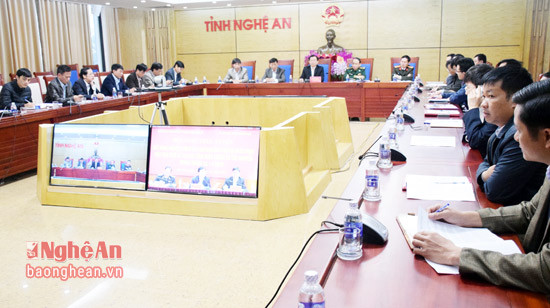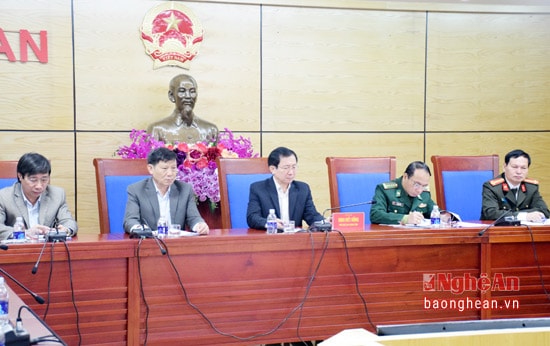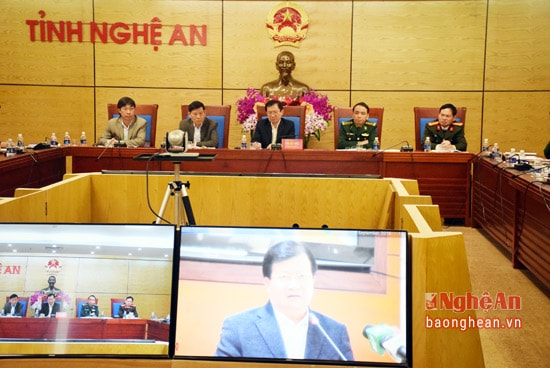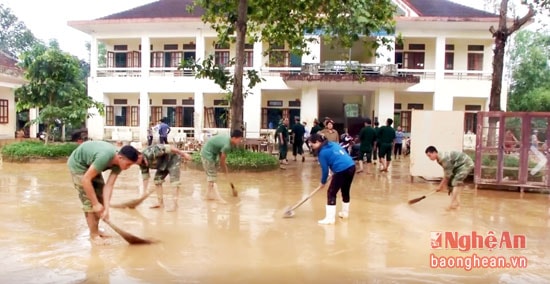Early support for flood victims to stabilize their lives
(Baonghean.vn) - On the morning of December 2, under the chairmanship ofDeputy Prime Minister - Trinh Dinh Dung,The Central Steering Committee for Natural Disaster Prevention and Control held an online conference to review experience in directing response and overcoming consequences of floods in the Central and Central Highlands provinces in October and November 2016.
At Nghe An, comrade Dinh Viet Hong - Vice Chairman of the Provincial People's Committee, Deputy Head of the Standing Committee of the Provincial Steering Committee for Disaster Prevention and Control and Search and Rescue chaired the conference. Also attending the conference were leaders of the following departments and branches: Agriculture - Rural Development, Planning - Investment, Construction, Transport - Communications, Finance, Industry and Trade, Natural Resources - Environment, Health, Communications, Labor - Invalids and Social Affairs, Provincial Military Command, Provincial Border Guard, Provincial Police.
 |
| Panorama of the online conference at Nghe An bridgehead. |
Since mid-October until now, the Central and Central Highlands regions have had four large-scale floods, including two in mid-October and early November 2016.
In the two major floods of October and November, the Central and Central Highlands provinces suffered serious consequences, with 65 people dead and missing, over 191,000 houses flooded, 22,151 hectares of rice flooded and damaged... Many sections of national and provincial highways... were flooded for long periods, causing landslides and traffic jams. Total material damage was estimated at over 7 trillion VND.
After the flood, the Government and ministries and branches focused on supporting and helping localities overcome the consequences. They provided 4,414 tons of food, 400,000 Cloramin tablets... The Government supported 305 billion VND for 14 provinces that suffered losses of 2,016 tons of rice seeds, 325 tons of corn, and 58 tons of vegetables.
Localities that suffered damage urgently deployed work to overcome the consequences. In particular, armed forces and youth were mobilized to organize the overcoming of consequences in terms of environmental sanitation, disinfection, sterilization, domestic water treatment, and provision of medicine.
 |
| Comrades participated in an online conference with the Government at Nghe An. |
After two major floods, the Government realized that the work of preventing, responding to, and overcoming the consequences of floods still has many difficulties, shortcomings, and challenges: Some people and local authorities are still subjective, lack response skills, and have not seriously and thoroughly implemented the telegrams of the Government and all levels, especially when floods rise quickly. Many reservoirs lack hydrometeorological monitoring equipment... coordination with localities and flood information is still limited. Rescue equipment of the main forces, especially in localities, is still lacking. The development of infrastructure, traffic, bridges, and culverts on national highways, provincial roads, North-South railways, economic zones... narrowing the flood drainage channel is one of the reasons leading to rapid rise in flood levels.
For Nghe An, in the three months of September, October and November, floods killed 11 people, injured 2 people, collapsed 65 houses, swept away 17 houses, damaged 104 houses, flooded 8,921 houses; 33,319 hectares of rice and crops were damaged... Many traffic works, irrigation works, schools, domestic water and other essential infrastructure were damaged. Estimated damage was about 1,364 billion VND. Up to now, Nghe An has basically overcome the immediate consequences, stabilizing people's lives.
 |
| Deputy Prime Minister Trinh Dinh Dung concluded and directed at the conference. |
Faced with the complicated and extreme developments of natural disasters in the coming time, and the storms and rains will end late, Deputy Prime Minister Trinh Dinh Dung concluded and directed: In the immediate future, localities will continue to mobilize forces to restore essential works, support people in flooded areas to restore their houses and production, and soon stabilize their lives, especially for households with dead or missing people; at the same time, focus on disease prevention for people and livestock.
Ministries, branches, localities, and organizations should investigate flood traces, identify floods; assess the impact and impacts on the lives and infrastructure of downstream areas of hydroelectric and irrigation reservoirs in the past two floods; propose to the Government fundamental solutions to ensure safe flood prevention and control, suitable for each current stage. Promote the construction of flood maps downstream of reservoirs to serve as a basis for reviewing, adjusting and supplementing response plans to rain and floods according to the "4 on-site" motto...
 |
| Authorities help people in flooded areas clean up as the water recedes. |
In the long term: Strengthen training, improve capacity and awareness for officials working on natural disaster prevention and control and the community; disseminate flood prevention experiences to the people. Quickly assess the current status of upstream and protective forests to have specific plans for new planting and forest protection. Minimize investment in construction of works and infrastructure that affect the area of upstream protective forests.
Review and adjust regulations, develop specific and appropriate mechanisms between the government and localities with owners of irrigation and hydropower reservoirs during flood control operations; have sanctions against reservoir owners who do not comply with flood discharge operations and do not fully equip necessary equipment to ensure the safety of reservoirs and downstream areas. Implement priority solutions to improve the capacity to respond to natural disasters in the context of climate change. Localities proactively build and install meteorological and hydrological monitoring stations; arrange and rearrange residential areas to ensure safety requirements for people.
Xuan Hoang
